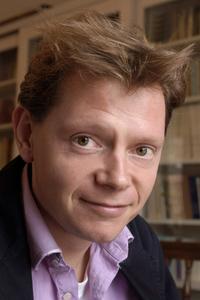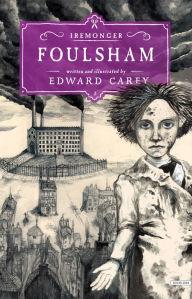
|
|
| photo: Tom Langdon | |
Author and illustrator Edward Carey is finishing the final illustrations for the last volume of his Iremonger trilogy. The middle grade series began in 2014 with Heap House (just released in paperback by Overlook Press), set in a vast rubbish heap in Victorian London, and continues in the just published Foulsham (hardcover, Overlook), set in a condemned shanty town bordering on London, where objects come alive and some of the citizens are fake people made out of dirt. Carey has worked as a playwright in England, Romania and Lithuania, and with a shadow puppet master in Malaysia. He also illustrated his first two adult novels, Observatory Mansions and Alva & Irva, the Twins Who Saved a City.
On your nightstand now:
Mary Helen Specht's novel Migratory Animals. I saw her reading at my local bookstore; the book sounds wonderful. The Door by Magda Szabo. I met someone who met her and described to me how strange and beguiling she was--she convinced me that this book has to be read. Barbara Comyns's novel Who Was Changed and Who Was Dead. I just finished her novel The Vet's Daughter--set in London, it's about a neglected child who can levitate. I adored it absolutely. It's strange and sinister and written with the most perfect prose.
Favorite book when you were a child:
The Weirdstone of Brisingamen by Alan Garner. This was the first book I felt I inhabited. It felt personal to me. It terrified me and made me fall in love with fiction. I read it about once every two years, and it still terrifies me. When I read it as a child, I started drawing the creatures that hide inside the abandoned mines, and I think this may have started me off wanting to be a writer-illustrator. Garner is a druid-type figure and he brings English folklore alive and writhing right in front of you, making you sit up in bed.
Your top five authors:
Charles Dickens. Bruno Schulz. Carson McCullers. Shirley Jackson. Bohumil Hrabal.
Book you've faked reading:
I've tried to read The Man Without Qualities by Robert Musil many times. I gallop through the first couple of hundred pages and cry, "This is the best thing ever written," and then I begin to slow, and get lost and more lost and end up throwing the book (the first volume) across the room but then rush to pick it up and apologize to it. I so want to read it, but I never succeed. I think there have been a couple of times when I've said to other people what a great book it is when I was reading the glorious beginning, but I have not necessarily fessed up to never arriving at the distant end (if it really has an end). The trouble with the man without qualities is he doesn't have any qualities. And if Musil can't finish it, why should I?
 Book you're an evangelist for:
Book you're an evangelist for:
The Hilda books by Luke Pearson. They're sophisticated comic books about a young girl in an everyday city (at first the countryside) who hangs around with trolls, and hounds that live between the walls, and birds that talk and who are kings, and miniature cities and giants who tread on houses. The imagination is so glorious, the artwork so beautiful. It's funny and dark and inspired.
Book you've bought for the cover:
Oho by Rex and Laurence Whistler. Brothers, Rex did the illustrations; Laurence did the words. It's a book that can be read any way up--the faces change when they're turned upside down. Rex was a famous painter in his day; his murals are still in the Tate Gallery restaurant in London. Some people suppose he was the inspiration for the character Charles Ryder in Brideshead Revisited. He died in World War II. His brother Laurence was a poet and an extraordinary carver of glass--he carved the windows in the church of St. Nicholas in Moreton, Dorset, England, where he engraved every window over 30 years.
Book that changed your life:
From the Beast to the Blonde by Marina Warner. I read it first about two decades ago and suddenly the world seemed to make more sense. It's a book about fairy tales--where they came from and who told them. Fairy tales describe what a human is, and what a human needs. Warner unlocked these tales and imagination for me. After reading her book, I felt I had permission to write with exaggeration, and that there is great inspiration in ordinary everyday things, like shoes or hair, and that it was perfectly sensible to have 10-league boots, people spitting frogs and fathers who ate their children in a pie.
Favorite line from a book:
"Mr. Chadband is a large yellow man, with a fat smile, and a general appearance of having a good deal of train oil in his system." From Bleak House by Charles Dickens.
Which character you most relate to:
Mole in The Wind in the Willows. Nice enough fellow, perhaps. No Toad.
Book you most want to read again for the first time:
Jakob von Gunten by Robert Walser. I so love this book about a school for servants, a very mediocre school, where the students are immediately told they "will amount to nothing." It's funny, unique, very dark and very odd.
Books written by and illustrated by the same person that you most admire:
William Blake is the patron saint of all illustrator writers. More recently the people who most inspire me to keep on drawing or painting my own stories are Alasdair Gray, whose Lanark is a strange fantastic hymn to Glasgow. Bruno Schulz's two books of short stories, which thankfully are still published with his delicate pencil drawings that somehow survived the Holocaust, though he and a novel did not. Mervyn Peake, who illustrated his Gormenghast books, but the publishers (among them Graham Greene) wouldn't allow him to publish the books with illustrations at first (but now that's been rectified)--the first two of these books are just glorious baroque imagination. Tove Jansson's Moomintroll books: what a crazy land, what characters and art. And Beatrix Potter's world: these sweetly captured animals and their stories can actually be very dark indeed--my favorite is about the orbicular rat, Samuel Whiskers, and his skinny wife, Anna Maria, who try to bake Tom Kitten.

